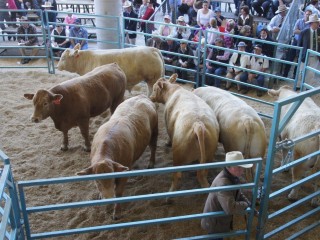 One comment that is increasingly being uttered throughout the cattle market as the year rolls on is “the numbers just aren’t there”.
One comment that is increasingly being uttered throughout the cattle market as the year rolls on is “the numbers just aren’t there”.
National cattle yardings last week were 24 percent lower than the same week last year and slaughter rates are running about 10pc below year-ago levels.
There have been several explanations for the restricted supply to market, including the lack of seasonal pressure on producers to sell and the retention of females for herd rebuilding.
While these remain key factors, others are increasingly pointing further back to the long-running drought of the 2000s as a primary cause of the current supply drought.
In the 2008 and 2009, as drought conditions gripped vast tracts of eastern Australia, large numbers of female cattle were sold for processing instead of breeding.
Peter Daniel, principal of Southern Queensland livestock agency Grant Daniel Long, said 10 to 15 years of drought were now catching up with the industry.
“I have been saying all year that the cattle can’t be out there, because it doesn’t matter whether you are in Goondiwindi or out at Windorah or wherever, everyone went through the same drought and were very low in numbers coming out,” Mr Daniel said.
“New South Wales is the same, numbers are very low there, everyone is suffering the same problem.
“The more people I talk to about it, they say the same thing – the penny is starting to drop that this is what is going on.”
Kurt Wockner, the livestock manager for Nippon Meat Packers’ Oakey processing plant, agreed with the sentiment over numbers.
“We’re paying for the numbers of store cattle that were killed in the droughts up until three years ago,” he said.
“People offloaded numbers and this is two or three years on, so these are your bullocks that were born in the last part of the drought.”
Oats finished cattle normally flow onto the market from this point, but that turnoff has also been curtailed this year.
Mr Wockner said many farmers had responded to higher wheat prices and higher store cattle prices by planting their entire farming areas to wheat, instead of planting part of their area to forage crops such as oats.
The main areas of supply at present are out of western areas of NSW and western and north western Queensland.
Elders national livestock manager Chris Howie told Beef Central that a lot of producers were engaging in herd rebuilding and were also looking to add more weight to cattle on-hand in response to current prices.
“Because of the prices over the last two years for restocking type cattle, many producers are carrying them through to get more weight in them,” Mr Howie said.
“To take them through from a 300kg to a 450kg animal and you’ve already paid $700, there is no margin.”
The positive seasonal conditions over such a wide area of eastern Australia meant there had not been the usual feed shortages and subsequent season-forced sales of cattle.
“We’re just seeing it inch up a bit in NSW now, but South Australia, Victoria and Queensland haven’t been under any pressure to sell,” Mr Howie said.
“People have had more of an opportunity to market their livestock, whether it be into specific markets or just to put on extra weight.
“But I think that if we see a seasonal return – if it gets hot and dry in the south from the end of September onwards – we will start to see those cyclic sale movements happen again.
“Last year that was completely removed because of rain for the entire summer and everyone had feed.”
The expected diversion of northern cattle displaced by the two-month halt live exports to Indonesia is also unlikely to play out on southern markets for several months.
Mr Wockner said the cattle that had exceeded weights for live export would be moved south to finish on grass, or grain for the top lines.
“Obviously every beast that doesn’t go out the Top End will come through an abattoir at some point, but as processors we won’t see that until April next year, at the very earliest.”
* There was a delay in the release of NLRS' weekly kill data yesterday afternoon due to public holiday disruptions in South East Queensland. Details will be reported on Beef Central as they come to hand today.
* Follow James Nason on twitter at @James_Nason



HAVE YOUR SAY